Massachusetts is not a very welcoming home for snakes. The 7th smallest state in the United States has harsh cold winters, giving snakes trouble hibernating here, so only a few chose this state to call home.
Due to its complex climate, only 14 snakes live in Massachusetts, and two of them are venomous. Most snakes are harmless, although they can bite if you try to handle them. The two venomous snakes are hard to spot because they prefer to live in isolated areas, far away from humans.
Throughout this article, we are taking a closer look at various species of snakes that live in Massachusetts and how to identify them.
Is Massachusetts An Ideal Habitat for Snakes?
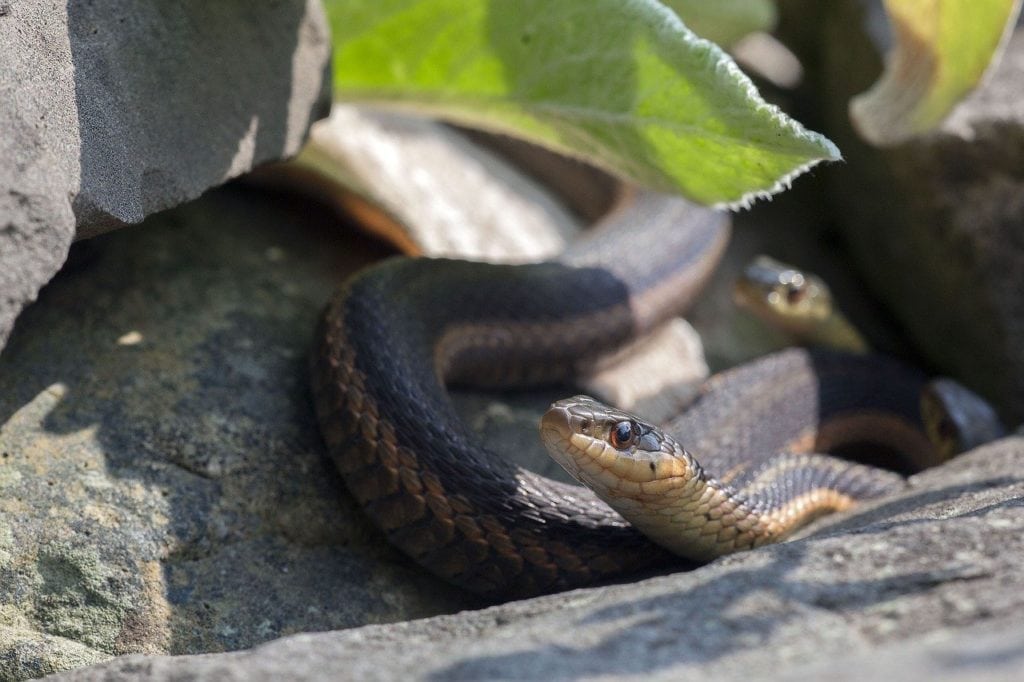
Massachusetts is not an ideal habitat for snakes because it has stone-cold winters. The snakes cannot go into hybernation if the ground is too icy. This cold-blooded animal doesn’t respond well to cold temperatures as it cannot self-regulate. The snake will be too numbed to digest food, and it will eventually stop eating, become sick and die.
Usually, during winter, snakes go into brumation. It is a form of hibernation where they do not constantly sleep, and they still wake up from time to time to hunt. Brumation helps the snake protect from cold temperatures and to conserve energy. As a rule of thumb, snakes go into brumation at about 60℉ (15℃).
Massachusetts has a humid continental climate with snowy winters and cool summers. During winter, temperatures have an average of 16℉ (-8℃). These types of winters aren’t ideal for snakes, as the ground is too cold for them to brumate.
Fun Facts

Out of all 14 snakes in Massachusetts, the longest is the Black Rat snake. This one can reach up to 101 inches (256cm), while most snakes living here go up to 50 inches (127cm). It is almost double their size, but at least it is not venomous.
The smallest snake that made Massachusetts its home is the Worm snake, and it looks like a worm and acts like one, spending most of its time underground.
The one species of snake that you can see all over Massachusetts is the Common Garter snake. You can encounter this one close to residential areas, sometimes even in yards and basements.
There are only two venomous snakes in Massachusetts, and both of them stay far away from humans and are considered endangered.
Let’s jump to the 14 species of snakes in Massachusetts.

Share This Image On Your Site
<a href="https://outforia.com/snakes-in-massachusetts/"><img style="width:100%;" src="https://outforia.com/wp-content/uploads/2022/04/Snakes-in-Massachusetts-infographics-04062022.jpg"></a><br>Snakes in Massachusetts Infographic by <a href="https://outforia.com">Outforia</a>You May Also Like: 31+ Snakes In Utah: ID Guide With Facts And Photos
Venomous Snakes
1. Timber Rattlesnake
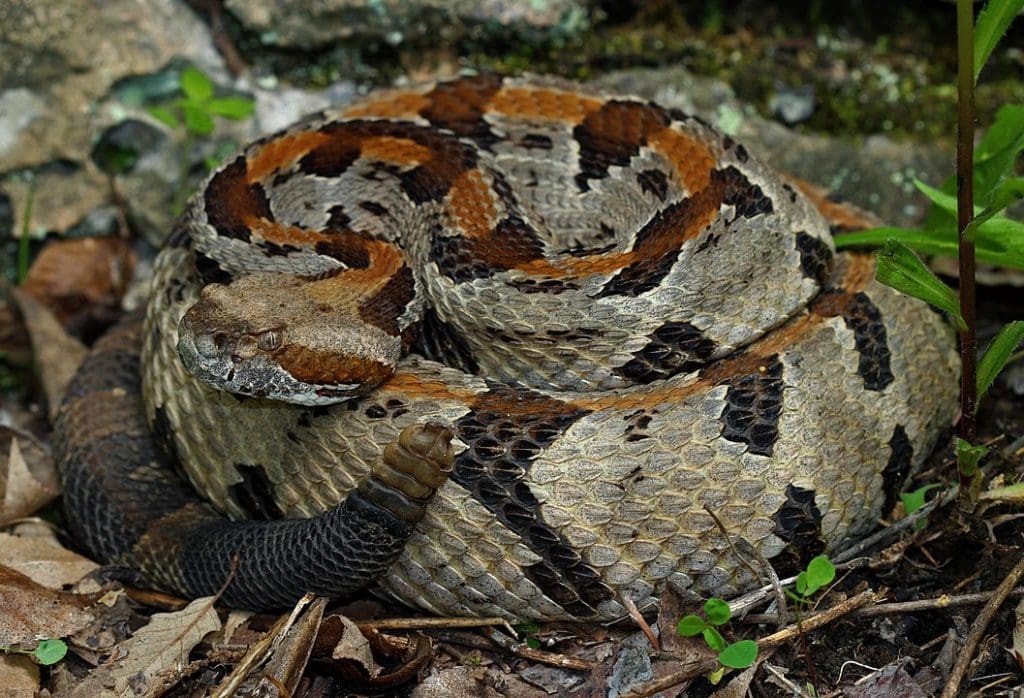
The Timber Rattlesnake is one of the two venomous snakes living in Massachusetts. It has all the distinct features of a venomous snake, from its triangular head and thin, cat-like pupil.
This snake varies in colors, and it can have shades of yellow, brown, gray or black. It spots V or M shaped crossbands along the back.
It is a medium-sized snake, and it can reach up to 60 inches (152 cm) and weighs 3.3 lb (1.5kg). They make a distinct rattle sound when they strike their tail to warn off predators.
Although this is a highly venomous snake, there were only two recorded deaths back in 1790 and 1791. These snakes are quite reclusive and prefer to stay away from humans as much as possible. They are not aggressive and usually flee from danger. They only choose to bite as a last resort.
Their winter habitat consists of rocky-hillside forests, and it moves to thick forests, heavy on foliage, during summer and autumn. Timber rattlesnakes eat small warm-blooded mammals like mice, chipmunks, rabbits, weasels and moles. They usually strike their prey and wait until the venom kicks off, then eat them.
Their common predators are foxes, birds of prey and raccoons. The Timber rattlesnake is considered an endangered species in Massachusetts, and it is illegal to kill or possess them.
2. Northern Copperhead
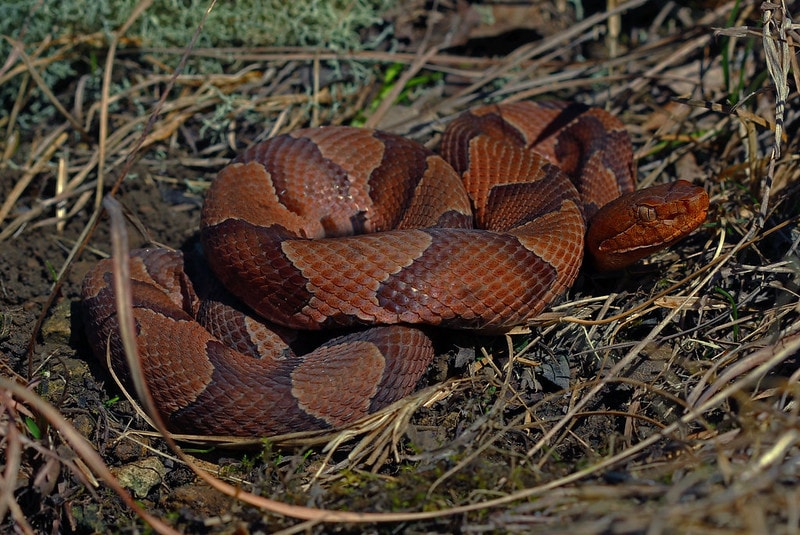
The Northern Copperhead is the second venomous snake in this county. Like the Timber Rattlesnake, this one also has a triangular-shaped head and vertical pupils. It is a heavy snake that reaches 53 inches (135 cm).
Its coloration varies from pinkish to gray-brown with orange or reddish crossbands on the back. The snakes’ head has no markings, and it is a dark brown copper. His body pattern helps it camouflage in the heavy foliage.
They aren’t very active snakes, as they tend to move slowly. When they feel threatened, they try to stay motionless to camouflage themselves. They are so reclusive that people rarely encounter them. The Copperhead lives in rocky forested hillsides and wetlands.
Copperheads are cataloged as pit vipers as they have a heat sensor right between their eyes. They use infrared sensors to locate their prey and judge its size. Their venom is not that potent, and they rarely release it preferring to use dry bites, false strikes or warning bites. They feed on rodents, birds, insects and frogs.
These snakes are also endangered and it is illegal to kill, harass or own them as pets.
Non-venomous Snakes
3. Worm snake

The Worm snake is so small and thin that it’s hard to spot. They have brown bodies with pinkish bellies and no pattern or markings. As its name suggests, it looks just like a worm, very smooth and its head is no wider than its body. This species feeds on earthworms or slugs, usually tiny creatures that can fit in their mouth.
In Massachusetts, the worm snake prefers sandy soils, and they live in southern Connecticut Valley. Their ideal habitat includes woodlands and rocky soils. They are pretty shy, so they never stay out in the open. You can find them under logs and rocks. Most often, just like a worm, they live underground.
Worm snakes don’t do well in dry climates. In summer, to evade the heat, they burrow underground and become active once the weather cools down.
These snakes are considered Threatened under the Massachusetts Endangered Species act, therefore, it is illegal to harass, kill, or own them.
4. Smooth Green Snake
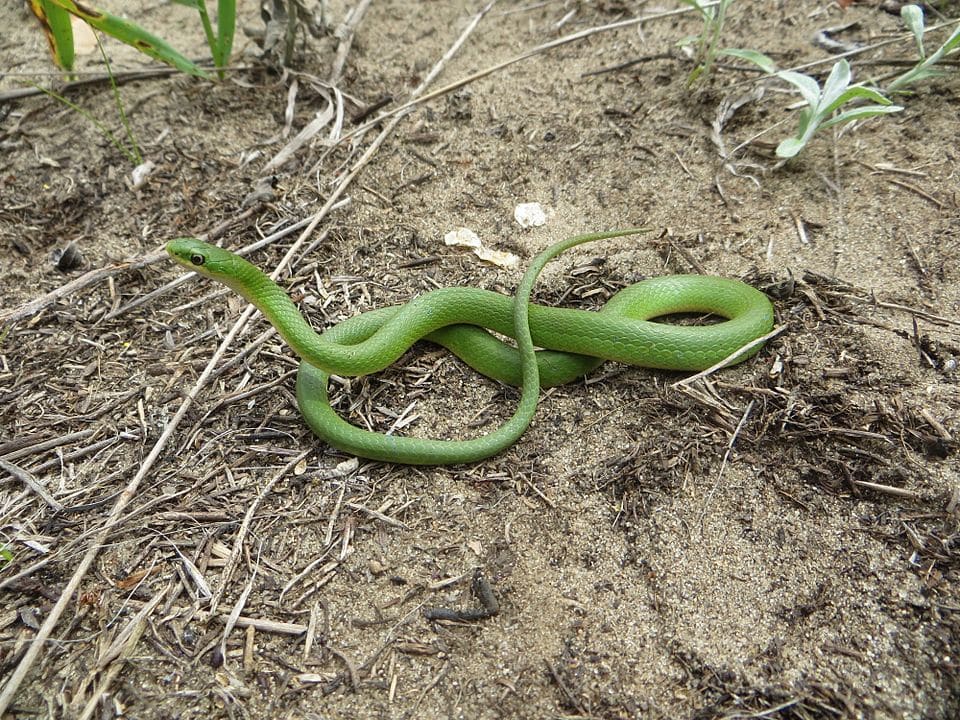
The Smooth Green snake is the easiest to identify. It is a green snake with no marks and patterns at all.
They are nonvenomous snakes that like to blend with their environment. Its preferred habitat is areas with thick vegetation like marshes, fields, wet meadows and bogs. They also got the grass snake nickname because they spend most of their time in thick grass.
They are gentle, harmless snakes that prefer to flee rather than bite, and even if they bite, they rarely break the skin. When this snake feels threatened, it will release a foul odor from its anal glands.
The Smooth Green snake feeds on grasshoppers, crickets, caterpillars, centipedes and spiders. They do not construct their prey, but they eat it in one bite.
5. Eastern Hognose Snake

The Eastern Hognose snake has a thick body and turned-up nose. It has many body color variations from yellow, gray, brown, olive or black. Their patterns vary from rectangular blotches on their back and dark spots on the side. Some snakes do not appear to have a color pattern because of their dark body. This snake can grow up to 46 inches (116cm).
The Hognose snake uses its upturned snout for digging in the soil, so its preferred habitat consists of sandy soil. It lives in woodlands, fields and farmland. Their main prey is the toad, but they also eat salamanders and small mammals.
It is a harmless snake, and when they feel threatened, they will flatten their heads like a cobra and lunge at its predator. They rarely bite and prefer to play dead to escape. Because they act like cobras, many people confuse this species with them and kill them.
Even though they are not a threatened species, it is still illegal to harass, kill or own Hognose snakes as pets.
6. Black Racer Snake
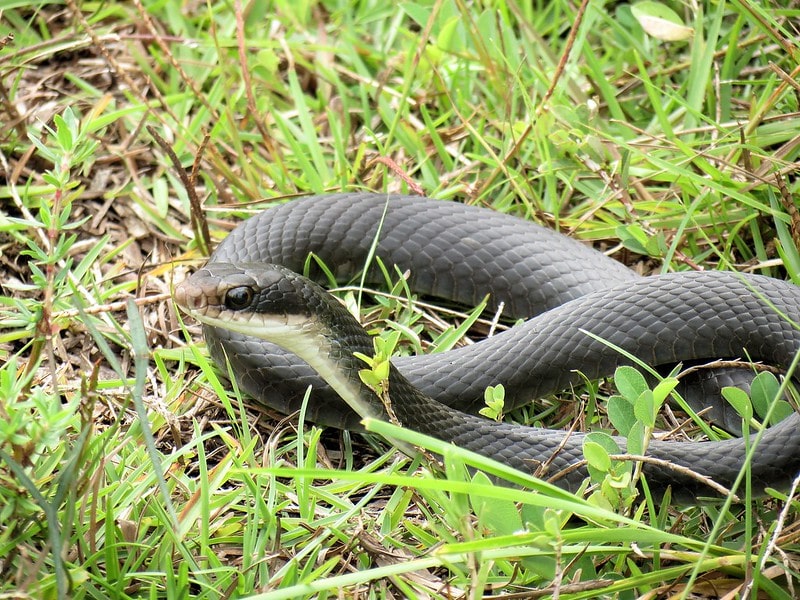
The Black Racer is a common snake in the United States. It is considered a gigantic snake that can reach up to 73 inches (185 cm). This snake is usually black with smooth scales. The chin and throat are usually a lighter color, white or gray.
This snake is found all over the state, and it is adaptable to many habitats. They can live in woodlands, pastures, fields, and rocky areas.
These snakes are very fast and have excellent eyesight. They like to raise their heads above the grass when they are crawlings. Their usual prey consists of small mammals, insects and other snakes. What’s unique about them is that they sometimes feed on their young.
The Black Races prefer to flee from dangers, especially since they are fast runners. If they cannot escape, they will attack and bite. This snake likes to mimic rattlesnakes and strike their tail against foliage to make that buzzing sound.
7. Eastern Ribbon Snake
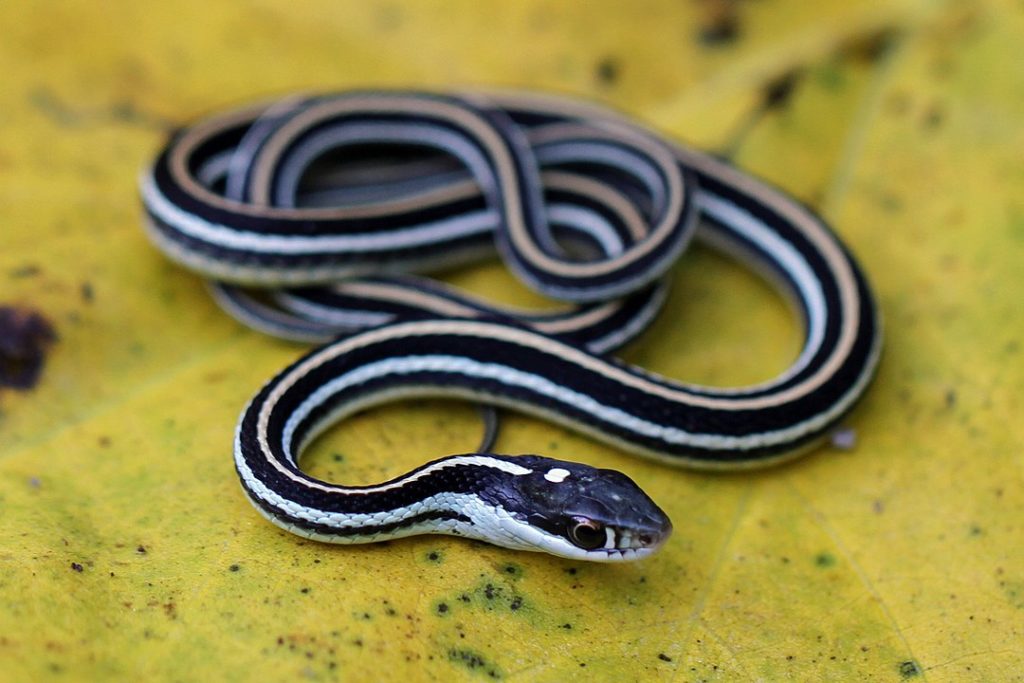
The Eastern Ribbon snake is a medium-length snake with keeled scales and a distinct body pattern. It presents an interesting color pattern with yellow and black stripes, while its body is a brownish color.
They like damp climates, and their natural habitats are in wetlands and near ponds and rivers. Since they live near a body of water, they eat amphibians like frogs, but they also go for fish and insects.
They do not do well in dry weather conditions, so they will become dormant until the weather gets better. Their most active season is spring because the weather is just right. They are great swimmers but also like to stay on the ground.
These snakes are harmless and do not like to bite people that try to grab them. However, they do release a foul smell when they feel threatened.
8. Northern Water Snake
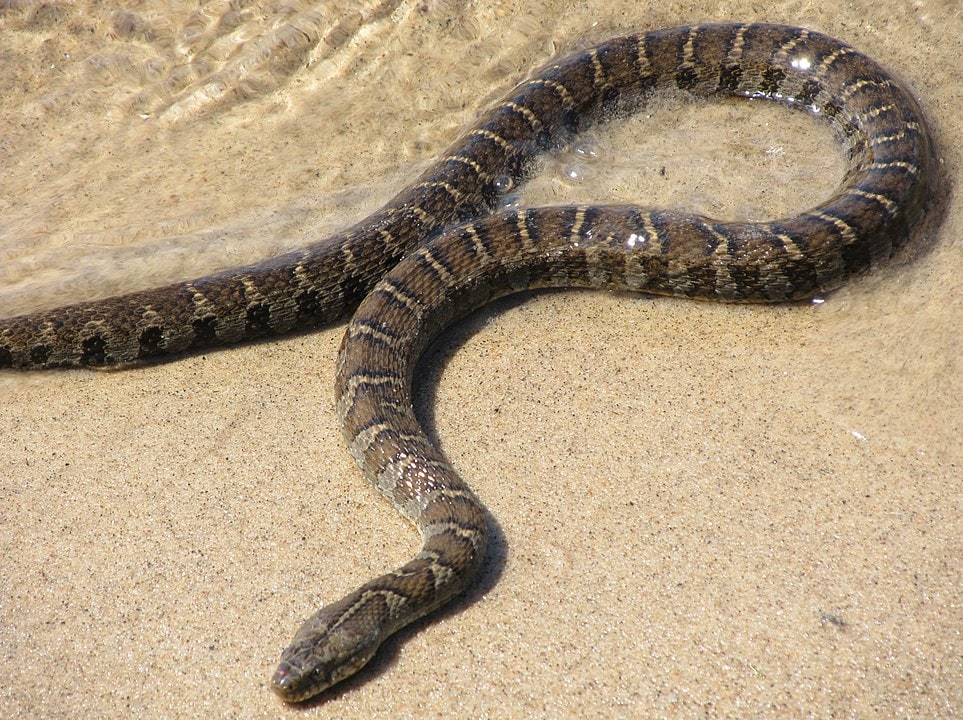
The Northern Water snake loves water, so their preferred habitats are lakes, ponds, streams, rivers and wetlands. It doesn’t come as a surprise that they are extraordinary swimmers both above and submerged.
This snake species varies in color. Their main body can be gray or dark brown and have dark crossbands near the head. They also spot dark blotches on their sides. You can spot them in water because they are quite thick and can reach up to 55 inches (140cm).
They are harmless snakes that do not attack humans. These snakes are often confused with Cottonmouth snakes, which are venomous. However, these don’t live in Massachusetts.
In spring, the Northern Water snake slides in backyards, and if they feel threatened, they will crawl back to the water. If you try to handle them, they will most probably bite, defecate and release a horrible smell.
9. Ringneck Snake
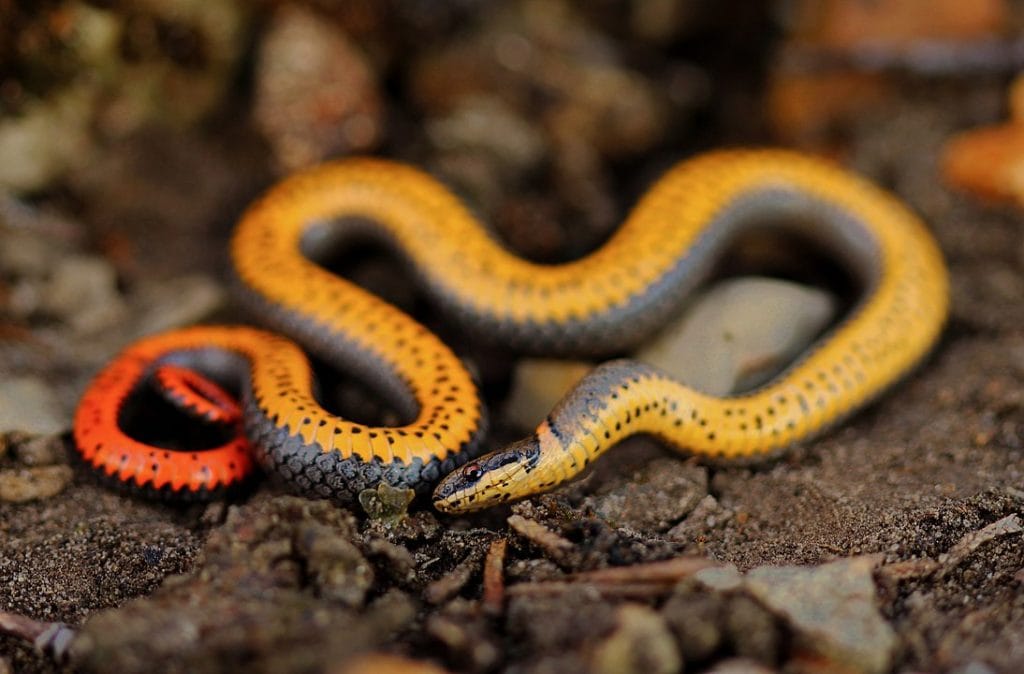
The Ringneck snake is easy to spot because it has a yellow ring around its neck. It is a small and slender snake that measures up to 15 inches ( 38cm). They have smooth scales and yellow or orange bellies.
They live in moist woodlands, where they can hide under rocks and debris. Sometimes these snakes can be found in basements. Their main prey is the redback salamander, but they also like to eat bugs and worms. Ringnecks are nocturnal snakes, active during spring and fall, while summers are too hot.
These small snakes are not dangerous at all to humans, but we wouldn’t recommend poking them because they will release a bad-smelling musk.
10. Brown Snake
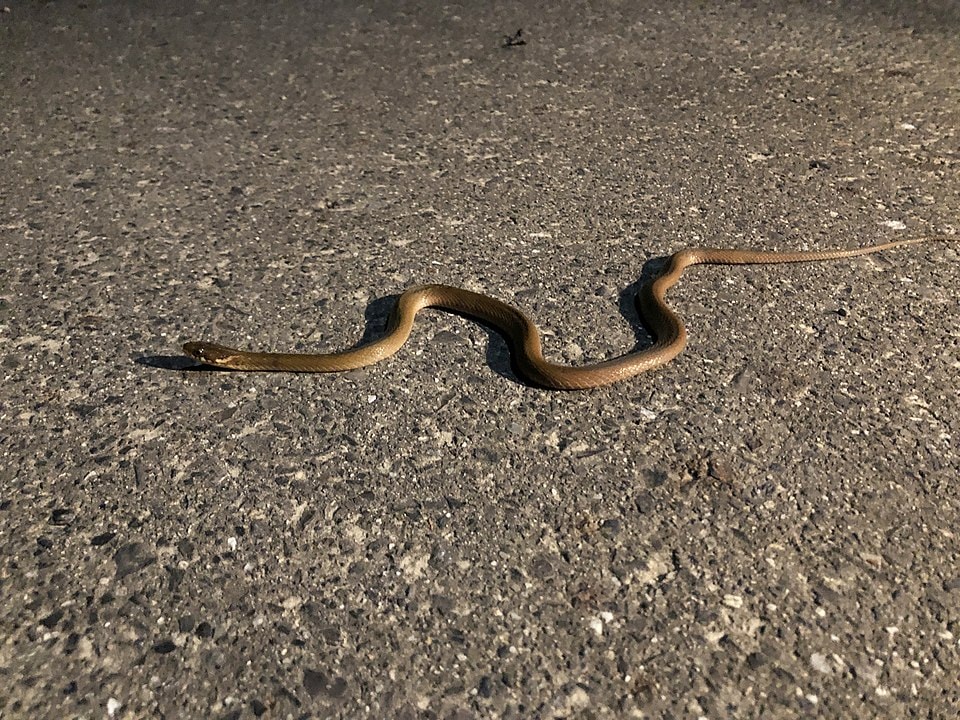
The Brown snake is not flamboyant, as it is brown and shy. It has a simple pattern of dark brown blotches down its back. These snakes brumate from November until spring. They only wake up briefly during warm winter days to hunt for food.
This species is highly adaptable to any habitat, and they can live in wetlands, grasslands and urban areas. You can spot them in backyards and gardens under rocks or other object
They like to feed on earthworms and slugs as their unique jaw allows them to remove snails from their shell. This species also goes for insects, bugs and small frogs.
Like most nonvenomous snakes, they don’t bite. When they feel threatened, they will stink up the place.
11. Black Rat Snake
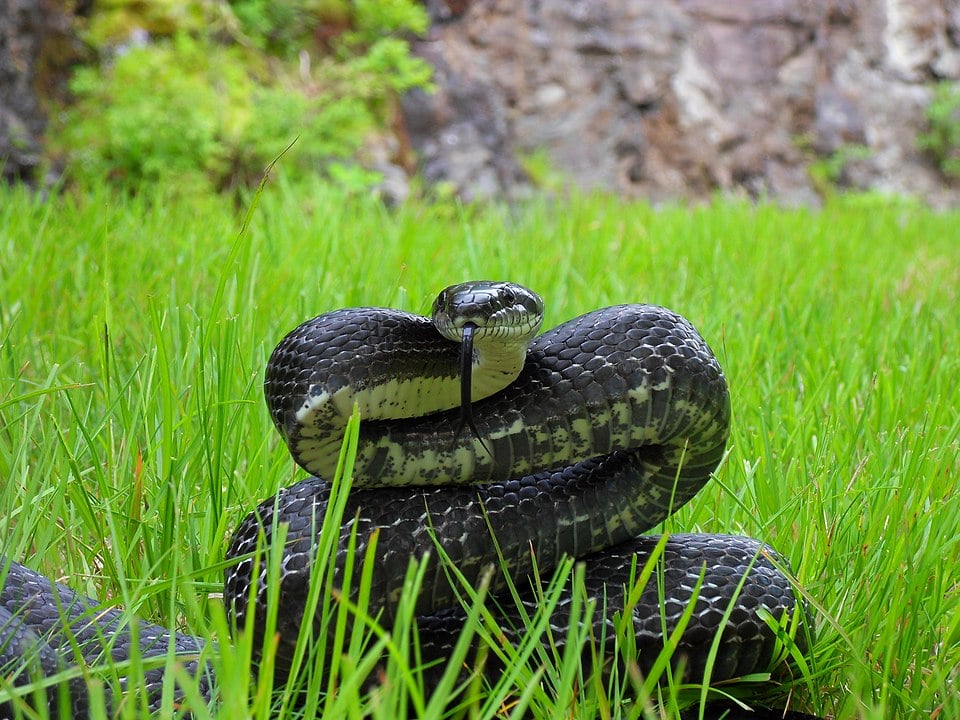
The Black Rat snake is the longest snake that lives in Massachusetts. It can reach up to 101 inches (256cm). Their body spots a majestic black coloring with white chins. They can be distinguished from the Black Racer snake by their length, as they are longer. The Black Rat snake also has a lighter belly, while the black racer has an all-black belly.
This species is a rare sight in Massachusetts, and they only live in Connecticut Valley and Worcester County and prefer forested hillsides and rocky areas. They like to eat mammals, birds and bird eggs. They are good tree climbers and invade bird nests or squirrel nests.
These snakes are not aggressive, but when they feel threatened, they will mimic the sound of rattlesnakes. They can bite, defecate or eliminate foul smells from their anal glands.
The Black Rat snake is considered Endangered, and it is illegal to harass, kill, possess or own them as pets.
12. Redbelly Snake
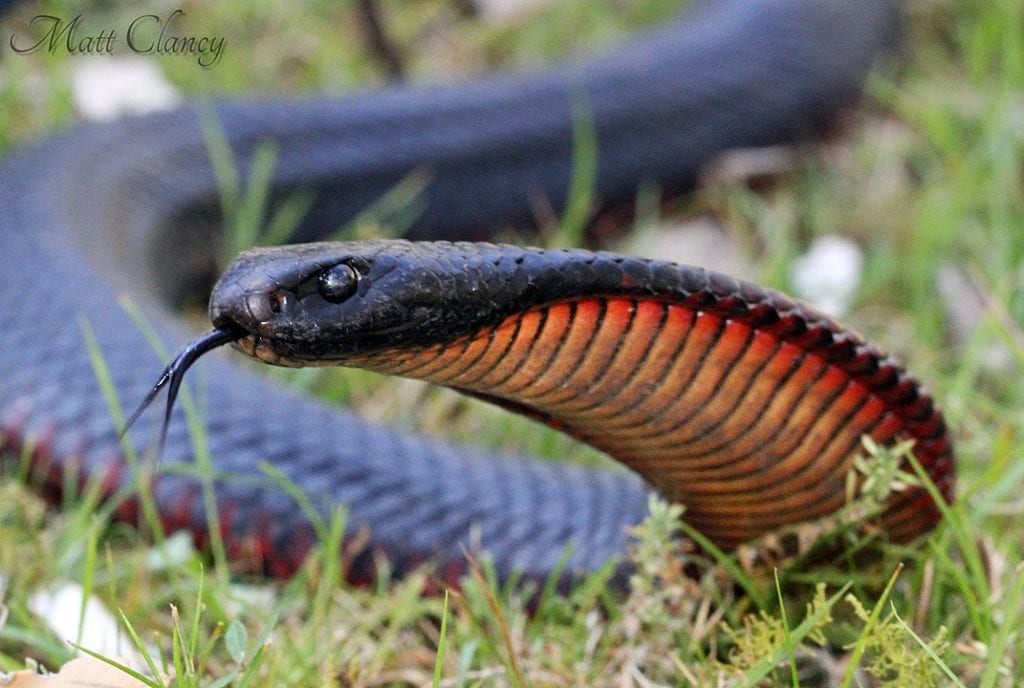
The Redbelly snake has a very noticeable yellow to red belly. It also has three lighter spots right behind its head. The main body can have a variety of colors from grey, brown and bronze. You can distinguish the Redbelly snake from the Ringneck snake from its keeled scale, while the later snake has smooth scales and a ring around its neck.
Its main habitat is the woodland, but they also like to live in meadows, fields and bogs. They are very shy snakes and spend most of their time hiding under rocks or logs. Their diet consists of slugs, earthworms, bugs and insects.
When they feel threatened, they will curl into a ball and show their teeth as a defense mechanism. They don’t like to bite as they would preferably release a putrid smell.
13. Milk Snake
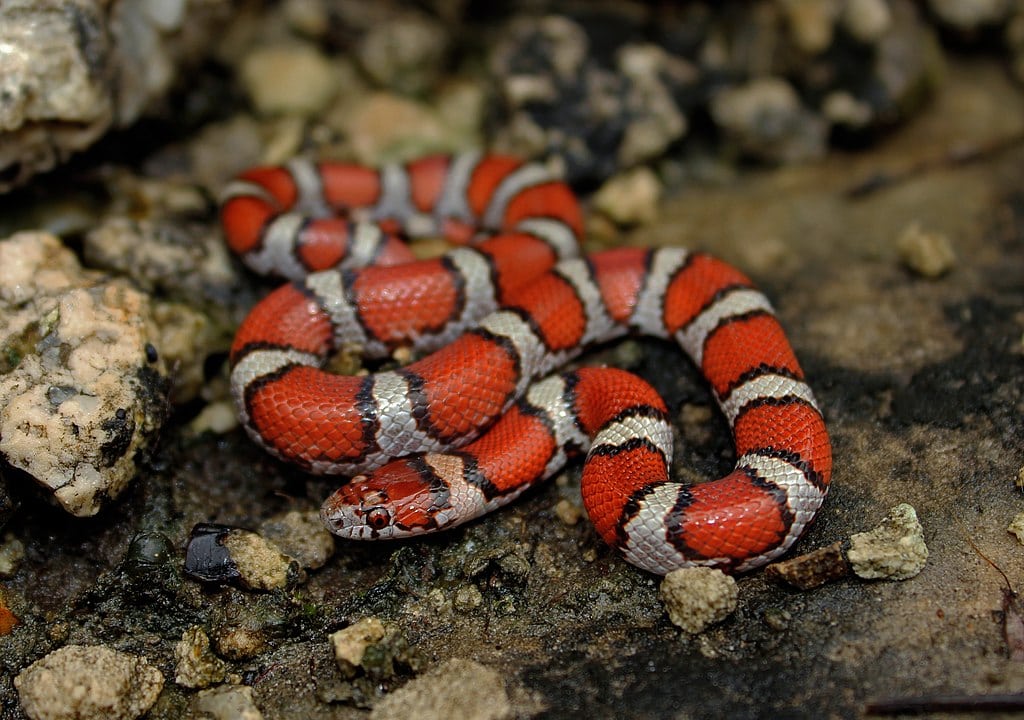
The Milk snake has an interesting pattern composed of a tan body covered with reddish-brown blotches on its back. It also spots dark crossbands between the splodges. It has smooth and shiny scales and can reach up to 52 inches (132 cm).
This species is quite adaptable, and while its habitats are the woodlands, wetlands and rocky hillsides, they also frequent houses and barns. They like to enter the burrows of small mammals and eat their younglings. Their diet also consists of other snakes, birds, frogs and earthworms.
The Milk snake is nocturnal and will hide under rocks and logs during the day. These pets are harmless to humans and docile, so they are kept as pets and bred in captivity.
14. Common Garter Snake
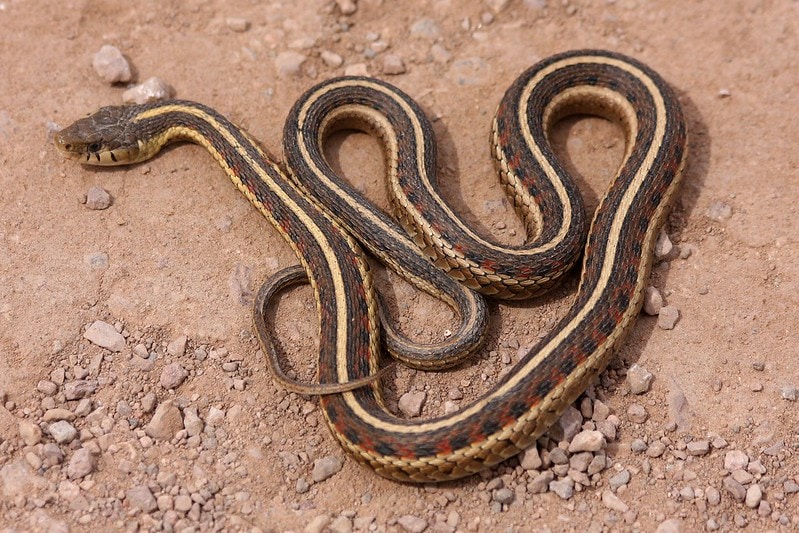
The Common Garter snake is the most familiar snake in New England. This snake has yellow stripes on a dark-colored body. They have keeled scales and yellow or green bellies.
You can also call this snake the garden snake because that’s where you will usually find it. However, it got the garter name after the old-school fashion of wearing garters. Garter snakes live in various habitats, from wetlands, forests and residential areas.
Their primary food consists of amphibians and earthworms as they have toxic saliva for small amphibians and mammals. If you get bitten by a garter snake, swelling or a rash might occur.
You May Also Like: 28 Snakes In Colorado: All You Need To Know (Pics & ID Guide)
Cultural References: Myths and Legends
Medusa and the Gorgons

In Greek mythology, The Gorgons are women with snakes instead of hair. The Gorgons had long claws, scales all over their bodies and sharp teeth. If you look at them, their gaze will turn you into stone. Medusa was once a beautiful woman, but she angered the goddess Athena with her foolish behavior. Medusa was fooling around with Poseidon and made Athena turn her into a Gorgon.
After many years, the hero Perseus went on a quest to slay Medusa, and Athena offered her help. She gave him a bronze shield, so Perseus would avoid Medusa’s gaze but still be able to see her movement. He managed to decapitate her and used her head to petrify his enemies.
You May Also Like: The 14 Snakes In Virginia That You Should Know About
FAQ
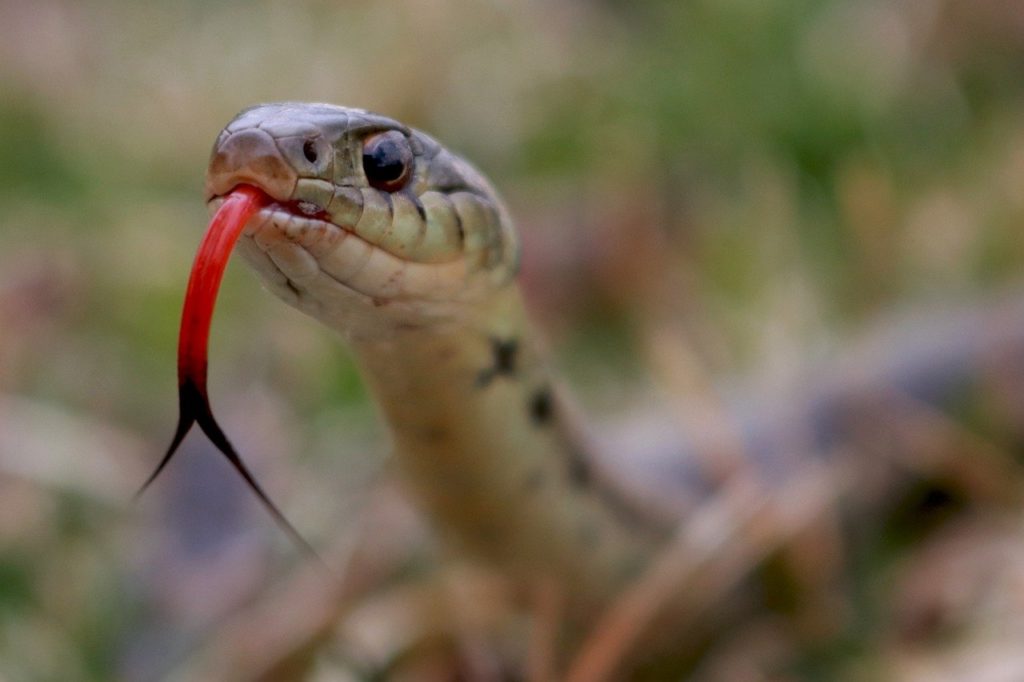
How to differentiate venomous from nonvenomous snakes?
You can tell venomous snakes from non venomous by their heads. The venomous snake has a triangular-shaped head, while the harmless snake has a round head.
Rattlesnakes, copperheads, cottonmouths, coral snakes have pits on their (holes) heads, right on their snouts. They use this as an infrared sensor to detect heat.
You can also tell snakes apart from their pupils. Venomous snakes have thin-black vertical pupils, almost cat-like, and their eyeball is yellow. All nonvenomous snakes have round pupils.
Overall, these two methods of determining whether a snake is dangerous or not are still inconclusive. It is still best not to try to handle the snake by yourself and contact a wildlife professional.








